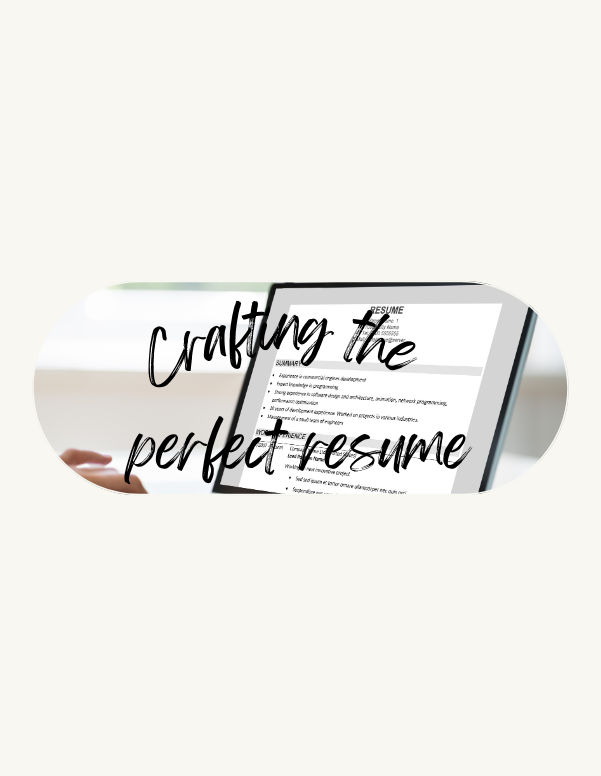
Crafting the Perfect Resume: Tips for Success
The hardest part of looking for a new role is having to edit your resume. ‘How should it look?’, ‘I don’t know where to start or what order to put things in.’, ‘Am I not getting calls because my CV isn’t impressive?’. These are just some of the questions that even I have thought about when I get don’t progress to the interview stage of the recruitment process.
Job searching can be a long, drawn out process which no one enjoys. We send out cv after cv and the majority of the time we hear nothing back which leads us to think our cv isn’t impressive enough. Trust me this is not the case. Every candidate’s experience is impressive you just simply have to present your experience in an impressive light from the beginning of your cv to the end.
Resume Layout
When I was recruiting I received countless cv’s with fancy backgrounds with company logo’s beside each of their previous employers, in my opinion this is unneccessary. You should keep your cv simple, instead of overloading it with graphics, shapes or images, you want to opt for a simple layout that complements your content. When recruiters send on your cv they do not include your image therefore why should you? Your personal photo should be used on your LinkedIn only. Ensure you choose a professional photo for your profile, it should be a front-facing headshot on a solid, light background in high resolution.
As a recruiter in one of my previous roles the first thing I looked at was length of service in each role. If you are only spending 3-6 months in each of your roles before you jump to the next, in my opinion, this hinders your chances. It makes the employer question the reasons behind your departure – Could you not handle the job?, Did you not pass your probation?, Were there performance issues?’ etc. In some cases the above are not the reasons the candidate left, the candidate may have simply felt that the role wasn’t as good a fit as they originally had thought, which is fine but if this happens to you once, then you should ensure that you are meticulous with your next job search. Fully research the role and company you are applying for, pay close attention to the job description and ask yourself if you can not only do the job and do it well but will you be happy performing these tasks and working for this company. Taking these extra measures will help to eliminate job hopping and help you get through that first hurdle.
Next I would look at the candidate’s work experience, only being interested in previous roles which were relevant to the position applied for. Your part-time job while in secondary school isn’t relevant therefore you can leave roles like this off your resume.
The next major thing about a cv is its presentation. Recruiters will not read a cv that is disorganised, meaning date’s not in chronological order, contains numerous spelling mistakes, it shows they did not proof read it before sending and that doesn’t contain transferrable skills to the role applied for. It’s painful but you should re-design your resume for each role you are applying for. If for example you are applying for the same type of role e.g. all HR Business Partner roles, then you don’t need to tweak your resume too much, simply revise the skills needed/ desired for the role and ensure your skills that match this are listed and are immediately visible to the readers eye.
What to include:
- Firstly start with your name at the top of the page and your contact details either directly underneath or to the left of the page. This makes it easy for companies to locate your contact details.
- Next, write a small blurb which sums up your experience, for example:
Strategic, creative and innovative HR professional who translates business vision into HR initiatives that improves performance, employee engagement, growth and profitability. Skilled in recruitment, retention, relationship building, learning & development and compliance while demonstrating exceptional communication skills and making critical decisions under pressure.
Then move onto the body of your CV:
- Work Experience
When listing your work experience, start with your most recent role, then list your other relevant roles. There is no requirement to include roles such as – Sales Assistant in Topshop or Sales Assistant in Supervalue back in 2012 as roles such as this are not relevant to the role you are applying therefore these can be left out.
2. Educational History
List any college degree’s, diploma’s or higher certificates you have achieved.
3. Skills
Place this section either directly under your education section or to the left under your contact information. You should always revise the job description for the role you are applying for and pay close attending to the Skill Requirements for the role and emphasise the skills mentioned that you possess.
4. Accomplishments
This section is where you can list any additional certificates or accomplishments you may posses, for example:
- First- Aid Certificate
- Microsoft Excel Certification
- Published article in the Sunday World
5. References
In my opinion there is no requirement to includes you professional and personal references on your resume. I prefer to only disclose this information when asked as you are sharing someone’s personal contact number and e-mail address therefore I would suggest a simple line - References are available upon request.

Post a comment